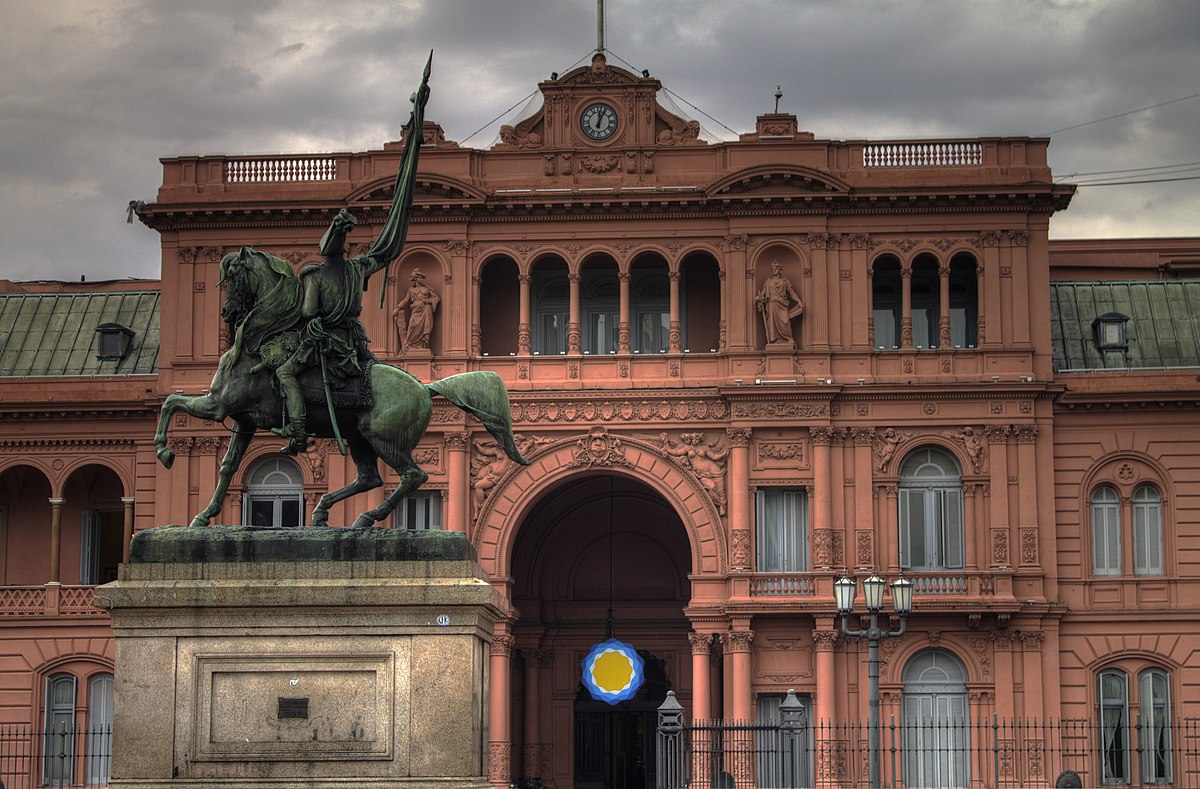Welcome to the Casa Rosada, also known as the Pink House, a South American government headquarters and a prominent Buenos Aires landmark. This historical and iconic building is notable for its distinctive pink color and plays a significant role in Argentine politics. Let’s discover the fascinating history, architecture, and cultural significance of the Casa Rosada.
Key Takeaways:
- The Casa Rosada, also called the Pink House, is a historical and iconic landmark in Buenos Aires.
- It serves as the seat of the Argentine national government and is a symbol of Argentine politics.
- The Casa Rosada offers free guided tours in English and Spanish, allowing visitors to explore its rich history.
- The iconic pink color of the building has become synonymous with Argentine culture and heritage.
- The Plaza de Mayo, where the Casa Rosada is located, has been a site of significant historical events and protests.
History of the Casa Rosada
The Casa Rosada, with its historical architecture and status as the executive mansion and residence of Argentinian presidents, holds a fascinating history. The construction of the Casa Rosada began on the site of a Spanish fort established in 1580. Over the years, it underwent various transformations, including becoming a customs house designed by British architect Edward Taylor.
Also read about: Explore Buenos Aires Architecture on Bike – Your Next Adventure
In 1862, under President Bartolomé Mitre, the Casa Rosada officially became the seat of the Argentine government. Subsequent expansions took place, and it is believed that President Domingo Faustino Sarmiento ordered the building to be painted pink, giving it its distinctive color. The Casa Rosada has served as the residence of several Argentinian presidents and has witnessed numerous key moments in the country’s history.
The Evolution of the Casa Rosada
Throughout its existence, the Casa Rosada has undergone significant changes in its design and purpose. From its origins as a fort to its current role as the iconic symbol of Argentine politics, the building has stood the test of time. Each expansion and renovation has added to its architectural splendor, making it a sight to behold for visitors from around the world.
Also read about: Complete Guide to Argentina Congress in Buenos Aires
Casa Rosada’s Influence on Argentine Politics
The Casa Rosada has always been at the center of Argentine political power. As the official government headquarters, it has witnessed the rise and fall of leaders, the implementation of policies, and the staging ground for pivotal moments in the nation’s history. Its iconic pink color has become synonymous with Argentine politics, making it a significant cultural and historical landmark.
The Casa Rosada continues to play a vital role in the country’s political landscape, serving as the backdrop for presidential announcements and addresses to the public. The famous balcony speeches by Juan and Eva Perón during the mid-20th century cemented the Casa Rosada’s place in history and popular culture.
The Casa Rosada’s Significance
The Casa Rosada stands not only as an architectural marvel but also as a symbol of Argentine identity and heritage. From its humble beginnings as a fort to its transformation into the seat of government, it represents the resilience and determination of the Argentine people. Visiting the Casa Rosada offers a glimpse into the nation’s past and its ongoing journey as a democratic nation.
Visiting the Casa Rosada
The Casa Rosada, with its historical significance and vibrant pink façade, is a popular tourist attraction in Buenos Aires. If you’re planning a visit, here’s what you need to know.
Free Guided Tours
One of the best ways to explore the Casa Rosada is by taking advantage of the free guided tours offered. These tours provide insightful information about the building’s history, architecture, and political significance. Guided tours are available in both English and Spanish, allowing visitors to fully immerse themselves in the experience.
Looking to start intensive Spanish courses in Buenos Aires?
To reserve a spot on a guided tour, simply visit the official Casa Rosada website. Keep in mind that it’s necessary to bring your passport for identification purposes. These tours provide a unique opportunity to learn about Argentina’s government headquarters and its role in shaping the nation’s history.
Casa Rosada Museum
Located behind the palace, the Casa Rosada Museum offers visitors the chance to delve deeper into Argentina’s rich heritage. The museum showcases exhibits that span from colonial times to the present, providing insight into the country’s cultural and political evolution. Entry to the museum is free, and it’s open on Wednesdays to Sundays, as well as on public holidays.
Inside the Casa Rosada Museum, you’ll find a variety of artifacts and displays that highlight key moments in Argentina’s history. From presidential memorabilia to exhibits on colonial times, the museum offers a comprehensive look at the country’s past. Don’t miss the opportunity to explore this immersive cultural experience during your visit to the Casa Rosada.
As you make your way through the Casa Rosada and its museum, you’ll gain a deeper understanding of Argentina’s vibrant history and its political significance. Whether you’re drawn to the iconic pink color, the architectural marvels, or the historical events that have taken place here, a visit to the Casa Rosada is a must for any traveler to Buenos Aires.
The Iconic Pink Color
The distinctive pink color of the Casa Rosada has become synonymous with Argentine politics and is a significant cultural heritage site. This iconic pink building stands out among the other structures in Buenos Aires, capturing the attention of locals and tourists alike.
Also read about: Independence Day of Argentina: The Heart of Cultural Pride
The exact origin of the pink color is a subject of debate and speculation. One theory suggests that the color was chosen as a way to diffuse political tensions by combining the colors of opposing political parties. Another theory suggests that the pink hue was achieved by using cows’ blood as an alternative to paint due to the high humidity in the area. Regardless of its origin, the pink color has become an integral part of the Casa Rosada’s identity.
As a symbol of Argentine politics, the Casa Rosada has witnessed countless significant events and protests throughout history. It has served as a backdrop for iconic moments, such as speeches delivered by Juan and Eva Perón from the balcony, as well as being a gathering place for political movements.
Table: Casa Rosada – Symbol of Argentine Politics
| Symbol | Description |
|---|---|
| Pink Building | The Casa Rosada’s distinctive pink color has become an iconic symbol of Argentine politics. It is instantly recognizable and represents the country’s political heritage. |
| Cultural Heritage Site | The Casa Rosada is recognized as a cultural heritage site, showcasing the rich history and significance of Argentine politics. It is a must-visit landmark in Buenos Aires. |
The Casa Rosada’s pink color continues to captivate visitors and serves as a constant reminder of Argentina’s political past. Exploring this iconic building and understanding its historical significance is a fascinating experience for anyone interested in the country’s culture and politics.


Architectural Features of the Casa Rosada:
| Architect | Design | Significance |
|---|---|---|
| Francisco Tamburini | Arch of Tamburini | An impressive entrance showcasing the architectural style of the late 19th century. |
| Francisco Tamburini | Overall layout | A harmonious blend of historical elements and architectural beauty, reflecting the rich history of Argentina. |
Interesting Trivia about the Casa Rosada
The Casa Rosada, with its illustrious history and cultural significance, holds several interesting pieces of trivia that add to its allure. One fascinating fact is that Roque Sáenz Peña was the only president who actually lived in the Casa Rosada, residing there from 1910 to 1914. As the seat of the Argentine government, the Casa Rosada is an amalgamation of various buildings that were constructed on the site over the years. Originally a fort established by the Spanish, it later transformed into a customs house and was eventually expanded to become the presidential palace. This unique evolution of the Casa Rosada showcases the rich layers of history and architectural transformation that it embodies.
In addition to its historical significance, the Casa Rosada offers a glimpse into the construction techniques of its time. The building’s distinctive pink color, a symbol of Argentine politics, is not merely due to paint but is the result of a combination of materials and methods used during the construction. This intriguing blend of construction elements further adds to the Casa Rosada’s architectural charm and mystique. The Casa Rosada stands as a testament to the skill and creativity of the architects and builders involved in its creation, making it a fascinating subject for architectural enthusiasts.
Visitors to the Casa Rosada can explore its interior and discover the intricate details that make it a masterpiece of design and craftsmanship. From the Arch of Tamburini, crafted by Italian architect Francisco Tamburini, to the various rooms and halls that once housed Argentine presidents, every corner of the Casa Rosada exudes historical significance. The fusion of architectural styles and influences within the building reflects the evolving nature of Argentine society and politics throughout the years. It is this blend of history, architecture, and cultural heritage that makes the Casa Rosada a must-visit destination for anyone seeking a deeper understanding of Argentina’s past and present.


Construction of the Casa Rosada
The construction of the Casa Rosada is a testament to the evolution of Argentine architecture and the country’s political history. The building’s origins as a fort under Spanish rule, followed by its transformation into a customs house, and ultimately its expansion to become the presidential palace, represent different phases in the nation’s development. Each stage of construction showcases the architectural styles and influences prevalent during that period, offering insight into the changing face of Buenos Aires and Argentina as a whole.
The Casa Rosada Museum
The Casa Rosada Museum, located behind the palace, offers visitors a fascinating glimpse into Argentina’s past through its collection of presidential memorabilia and exhibits showcasing the country’s colonial history. The museum serves as a cultural repository, preserving and presenting artifacts that shed light on Argentina’s rich heritage.
Step into the museum and you’ll be greeted by a diverse range of exhibits that chronicle the country’s historical narrative. From colonial artifacts to personal belongings of past presidents, the Casa Rosada Museum provides a unique opportunity to delve into Argentina’s political and social history.
One of the highlights of the museum is a mural created by Mexican artist David Alfaro Siquieros. This magnificent artwork depicts important scenes from Argentine history, capturing the spirit and struggles of the nation. As you explore the museum, you’ll also come across interactive displays and informative panels that provide further insights into Argentina’s colonial past and the impact of its presidents on the country’s development.
The Casa Rosada Museum
The Casa Rosada Museum, located behind the palace, offers visitors a fascinating glimpse into Argentina’s past through its collection of presidential memorabilia and exhibits showcasing the country’s colonial history. The museum serves as a cultural repository, preserving and presenting artifacts that shed light on Argentina’s rich heritage.
| Exhibit | Description |
|---|---|
| Presidential Memorabilia | This section of the museum showcases personal belongings, documents, and gifts received by former presidents of Argentina. From intricate artifacts to historical photographs, visitors can gain unique insights into the lives of past leaders. |
| Colonial History | Explore the colonial era of Argentina through exhibits that highlight the country’s early settlements, the influence of European powers, and the struggles faced during this period. Learn about the indigenous cultures and their interactions with the colonizers. |
| Art and Culture | Discover the artistic and cultural heritage of Argentina through displays of traditional crafts, paintings, and sculptures. This section celebrates the country’s vibrant artistic traditions and the contributions of renowned Argentine artists. |
Visiting the Casa Rosada Museum is a captivating journey through Argentina’s history. Whether you’re a history enthusiast, a political buff, or simply curious about the country’s past, this museum provides a comprehensive and immersive experience that shouldn’t be missed.
The Plaza de Mayo is not only visually stunning but also holds a deep historical and political significance for Argentina. It has been a site of mass protests and symbolic gatherings, providing a platform for the public to express their opinions and demands to the government. Over the years, the plaza has witnessed protests by various groups, including the Mothers and Grandmothers of the Plaza de Mayo, veterans of the Malvinas War, and other political movements.
Surrounding the Casa Rosada and Plaza de Mayo are other architectural marvels such as the Cabildo, a historic government building, the May Pyramid, a monument commemorating the May Revolution, and the Metropolitan Cathedral of Buenos Aires. These landmarks collectively create a vibrant and culturally significant area that showcases the city’s heritage and historical importance.
Plaza de Mayo and its Historical Significance
The Plaza de Mayo has played a crucial role in Argentina’s history, serving as a central gathering place for important events and movements. It became the epicenter of political activism during the Dirty War, as the Mothers and Grandmothers of the Plaza de Mayo protested against the disappearance of their loved ones. These brave women demanded justice and accountability from the government, leaving an indelible mark on the country’s collective memory.
Today, the Plaza de Mayo continues to be a symbol of resilience and civic engagement, reminding visitors of Argentina’s complex past and the ongoing struggle for social justice. It is a place where history comes alive, inviting both locals and tourists to reflect on the country’s turbulent past and its aspirations for a better future.
Protest and Political Significance
The Plaza de Mayo, with the Casa Rosada as its backdrop, holds immense political and historical significance in Buenos Aires. It has been a site of mass protests and symbolic gatherings for decades, serving as a powerful platform for the public to voice their opinions and demands to the government. The plaza has witnessed countless demonstrations by various groups, including the renowned Mothers and Grandmothers of the Plaza de Mayo, veterans of the Malvinas, and other political movements.
Do you want to learn Spanish? Best Spanish schools in Malaga
The mass protests held in the Plaza de Mayo reflect the deeply ingrained spirit of activism and political engagement in Argentina. The open space in front of the Casa Rosada provides a rallying point for individuals and groups to come together and express their concerns, advocating for social justice, human rights, and political change. The plaza has become a symbol of resistance and resilience, representing the unwavering determination of the Argentine people to fight for their rights.
The Plaza de Mayo has seen historic moments of unity and dissent, as well as the mobilization of social movements that have shaped the course of Argentine history. Whether it be demanding justice for the victims of human rights abuses during the Dirty War or advocating for economic reforms, the plaza remains a significant platform for political expression and civic engagement. It embodies the collective struggle for a more equitable and democratic Argentina.
Examples of Significant Protests and Gatherings
| Date | Protest/Gathering | Key Participants |
|---|---|---|
| October 17, 1945 | Descamisados’ March | Supporters of Juan Perón |
| April 30, 1977 | Mothers of the Plaza de Mayo | Mothers demanding justice for their disappeared children |
| March 24, 1980 | Madres de Plaza de Mayo Founding | Mothers demanding accountability for human rights violations |
| April 2, 1982 | Veterans of the Malvinas | Veterans advocating for recognition and support |
| March 24, 2000 | 30,000 Silhouettes | Protest against impunity for human rights abusers |
These examples represent just a fraction of the significant protests and gatherings that have taken place in the Plaza de Mayo. Each event has contributed to the ongoing dialogue and activism in Argentina, serving as powerful reminders of the country’s complex political landscape and the resilience of its people.
Conclusion
The Casa Rosada, with its rich history, iconic pink color, and significant role in Argentine politics, stands as a symbol of the country’s cultural heritage. This South American government headquarters has been the residence of many Argentinian presidents and has witnessed countless historical events.
Visiting the Casa Rosada is a must for any tourist in Buenos Aires. The free guided tours provide a fascinating insight into the building’s history and its impact on Argentine politics. In addition, the Casa Rosada Museum offers an opportunity to delve deeper into Argentina’s colonial past and explore presidential memorabilia.
Located in the historic Plaza de Mayo, the Casa Rosada not only offers architectural beauty but also represents a space where the public can voice their opinions and gather for protests. The plaza has seen significant political movements and serves as a reminder of Argentina’s fight for justice and democracy.
By exploring the Casa Rosada and its surroundings, visitors gain a unique understanding of Argentina’s past and present. Whether it’s admiring the architectural charm, learning about the country’s history in the museum, or witnessing a political gathering in Plaza de Mayo, the Casa Rosada offers an enriching experience for all who visit.






